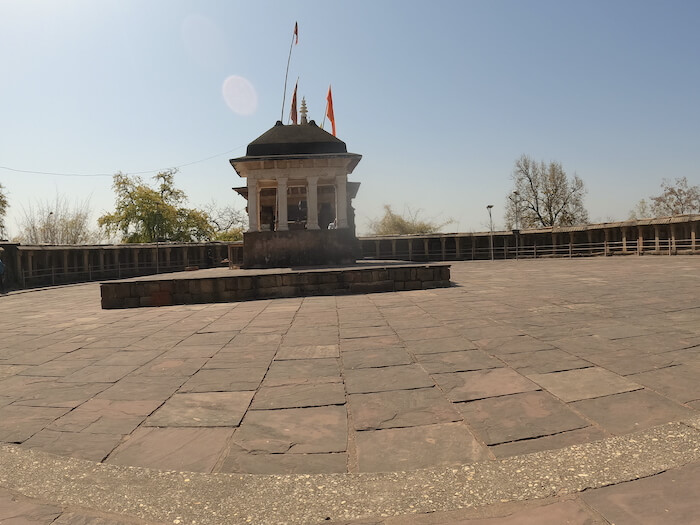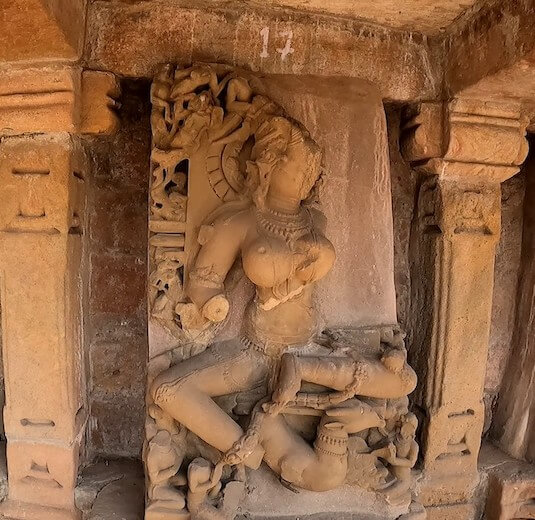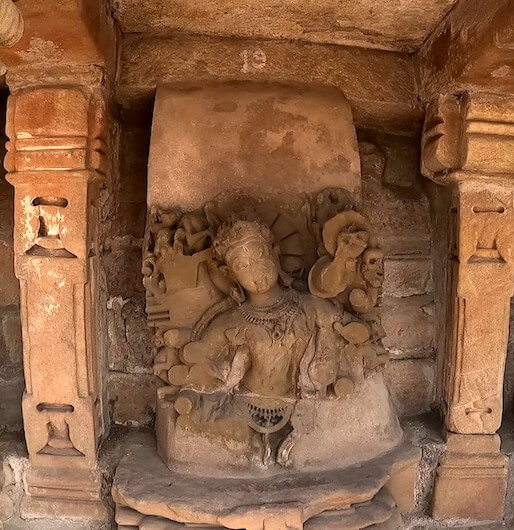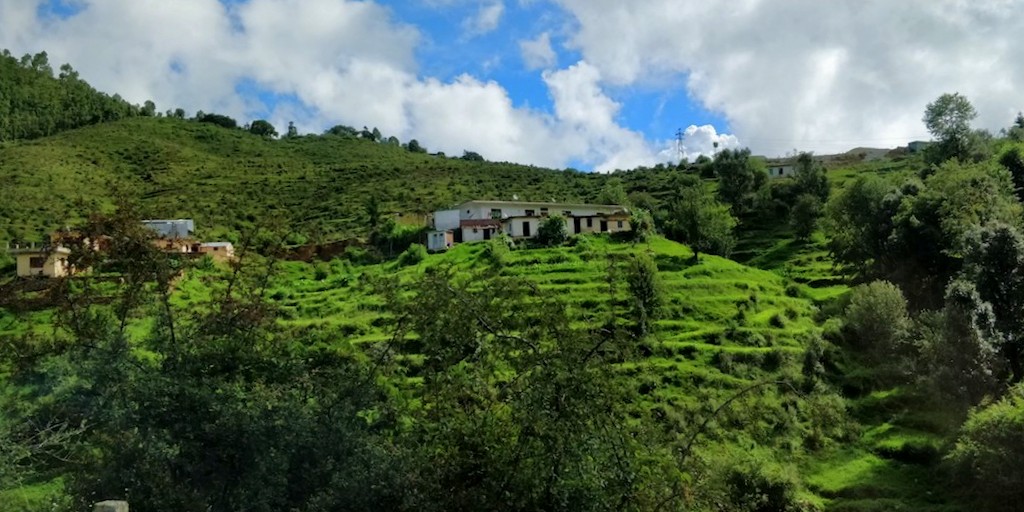The 64 Yogini Temple Jabalpur located near Bhedaghat in Madhya Pradesh, India, is the largest of the circular-shaped Yogini temples found in the country. Like other Yogini temples in India, the Chausath Yogini Temple, Jabalpur, is also bereft of architectural and sculptural grandeur and elaborate ornamentation that are the hallmark of temples in India.
The different Yogini temples of India are simple structures, generally circular, and hypaethral, i.e. open to the sky. Here we look at the history and architectural design of the Chausat Yogini Temple Bhedaghat. But before that, it is necessary to understand the evolution of Yogini temples, the general structure of Yogini temples, and most importantly, the Yoginis, themselves.
Table of Contents
64 Yogini Temple Jabalpur – Chausat Yogini Mandir Bhedaghat
Madhya Pradesh, the heart of India, has some of the most incredible heritage sites in India. These include places like Khajuraho, Sanchi, Bhimbetka, Chanderi, Gwalior, and many more.
The state is strewn with heritage temples, mosques, palaces, tombs, and cenotaphs from different periods of history. One such site that is lesser known but no less interesting is the Chausat Yogini Temple Jabalpur.
The disfigured sculptures, many of them brutally vandalized tell a tale that dates back hundreds of years ago. The river Narmada flows silently in the distance, carrying the secret tales of history safely in its bosom. Read on to know more about Chausath Yogini Temple, Bhedaghat.
64 Yogini Temple Jabalpur – Chausath Yogini Temple History

It is imperative that one understands albeit briefly, the Chausath Yogini Temple Jabalpur history, before delving deeper into more details of the temple. The Chausath Yogini Temple, Jabalpur was built by King Yuvaraja II who belonged to the Kalchuri dynasty having their base in the ancient city of Tripuri. The Kalchuri dynasty ruled over parts of Central India, between the 11th and 13th centuries.
This dynasty is not to be confused with an earlier dynasty of the same name, the Kalachuris of Mahishmati, who held sway in the region between the 6th and 7th centuries.

It is interesting to note that the city of Tripuri was probably visible from the hilltop on which the temple was built, as the Chausath Yogini Temple Jabalpur distance from Tripuri was a few miles. The city of Tripuri was situated beyond the flowing waters of the Narmada river.
Historians agree that the temple to the 64 Yoginis, the companions of the goddess Kali, was built at the end of the 10th century under the Kalachuri dynasty. Though most of the sculptures found inside the temple belong to the Kalachuri period, there are some that historians identify as belonging to the Post-Gupta period of the 7th Century CE.
There is a temple known as Gowri-Shankar Temple built at a later date that historians believe was built around the 12th century CE, sometime before or after the lifetime of a Kalachuri queen named Alhanadevi. This is based on an inscription slab that was found at the site. However, there is some ambiguity here as not all historians are in agreement.
Chausath Yogini Temple Bhedaghat – Who Are The Yoginis?
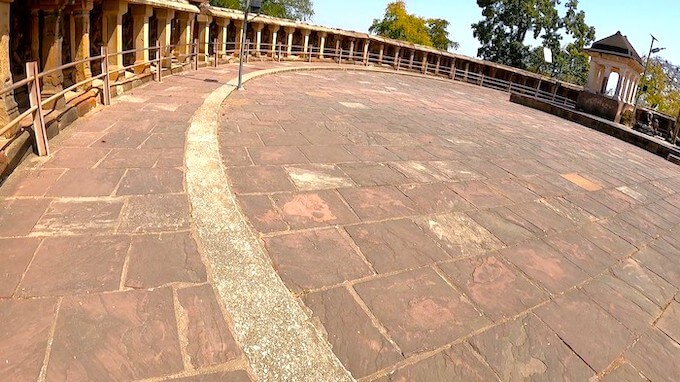
The Yoginis have been at the centre of tantric worship in Hindu Tantra outside of the Vedic religion. Not much has been known about the Yoginis as Tantric worship was done secretly, and not many were even aware of the old tantric temples where tantric rites were practised.
The Yoginis are considered to be manifestations of Shakti and also include the Ashta Matrikas, namely, Brahmani, Vaishnavi, Maheshwari, Indrani, Kaumari, Varahi, Chamunda, and Narasimhi. They are also believed to be the female counterparts or manifestations of male Gods like Shiva, Vishnu, Brahma, etc.
Though Yoginis were worshipped as divine beings with supernatural powers that included shape-shifting, that is the ability to assume and change forms, and the ability to fly. Yoginis were also female masters of Yoga who practised severe Tantric rites and aspired for supernatural powers and attainment of various Siddhis including the power to fly.
In fact, the power to fly was one of the primary powers of Yoginis and that is the reason that all Yogini temples are hypaethral (open to the sky).
The Yoginis appear in groups, usually 64, and hence the etymology of Chausath(64) Yogini temples, however, they also have been seen in larger groups, for example, the Chausath Yogini Temple Bhedaghat, Jabalpur, itself has images of 81 Yoginis. So the name Chausath Yogini is in itself a misnomer in this case.
The Yoginis are thus considered to be Tantric Goddesses who are the attendants of various manifestations of Goddess Durga or Goddess Kali. 64 Yoginis were aligned to the eight Matrikas, each Matrika had 7 Yoginis attached to her, and thus the group of 64 Yoginis was arrived at. Later the eight Matrikas became nine, with the addition of Mahalakshmi.
These 9 Matrikas had 8 Yoginis aligned to each of them, which resulted in a cluster of a total 0f 81 Yoginis including the Matrikas. Thus it may be seen that the Yoginis are considered daughters or manifestations of the Matrikas themselves.
Reference to the cluster of 81 Yoginis is found in an ancient manuscript in Nepal, which describes the Mula Chakra in the Sri Mattotara Tantra.
The Evolution of Yogini Temples In India
The concept of Yogini worship in India evolved around the 9-10th century and this saw the rise of the Yogini temples. However, Tantric practice was done secretly, as it involved bizarre tantric rituals and black magic. It is because of this reason that these temples were in remote and inaccessible areas. Most of the Yogini temples date back to periods between the 10th and 12th centuries.
It is believed that the concept of Yoginis evolved from tribal or village Godesses, and later found their way into Tantric worship. The tribal female deities were aligned with the mainstream Hindu Goddesses, namely the different forms of Parvati, Kali, or Durga. However, Yoginis remained outside the ambit of Vedic religion.
Visiting Chausath Yogini Temple Bhedaghat Madhya Pradesh
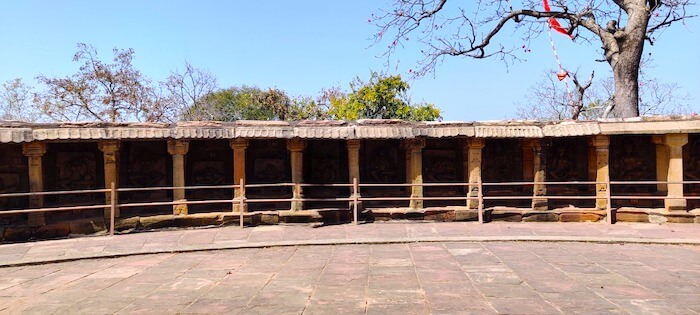
The path that leads to the Chausath Yogini Temple lies inconspicuously by the side of the road that leads from Jabalpur town to Bhedaghat. It is located on a hilltop next to the famous Dhuandhar Falls in Bhedaghat. It is also known as Golaki Math, for obvious reasons.
A board put up by the Archaeological Survey of India in Hindi gives some details about the monument. As you walk past the board, you come upon a flight of steep steps that lead upwards. You need to negotiate these 100-odd steps to reach the top of a hill on which the Chausath Yogini Temple of Jabalpur stands.

The climb is not that difficult if you are in good shape, however senior citizens and those with knee issues would need to take a call. If you are averse to negotiating the steep steps. there is a ramp-like incline beside the steps that you can take, but that option too is not that easy. There are stone benches provided midway, in case you want to catch your breath or appreciate the view.
Once you have successfully negotiated the steps, you reach the top. We found a paved open space with a couple of trees and stone benches. As we crossed this space, we stood bang in front of a circular wall that must have been around 10-12 feet in height. This wall runs around the Chausath Yogini Temple and screens it completely from those wanting to peep inside. A small door in the wall provides access to the temple complex.
It was early afternoon and hardly anyone was there inside the temple when we entered. A strange feeling gripped us as we stood in the centre of a huge circular structure. We felt as if we were being observed!
They were looking at us from all directions, 81 0f them, and there was no escaping their gaze, they were the Yoginis who sat in bewitching postures in the small enclosures that housed them on the circular pathway that ran around us.
Most of the stone images depicted the Yoginis in the Lalitasana posture. This Asana is also referred to as the “Royal Position.” In Lalitasana, the figure is seated on a throne with one leg tucked inwards and the other leg hanging freely from the seat or throne. Lalitasana is a common way of the depiction of many of the Hindu Gods and Goddesses.
It was a different matter, and a sad one that most of the Yoginis were damaged, their heads cut off, their arms dismembered. But there were quite a few of the Yogini sculptures that had managed to escape the gaze of the marauders who must have violated the sanctity of the temple. Whatever be their state, these stone images of the Yoginis though a shadow of their original splendour, even today manage to evoke a sense of awe in the beholder.
We started walking and observing each one of the cells that housed a Yogini or some other deity from the Hindu Pantheon. We started from the cell that was immediately to our left as we entered through the small door. The cells were numbered with chalk, however, we found the numbering awry, with numbers being skipped here and there. The names of the occupants of each of the cells were written in Hindi and English, but many of these were partially or completely faded.
We hope that the authorities including the Archaeological Survey of India, and Madhya Pradesh Tourism, take measures to ensure that the cells are numbered and labelled properly.
64 Yogini Temple Jabalpur – The Yoginis

Here are some of the Yoginis and other deities that adorn the 64 Yogini temple with images. We have given images of only some of the divinities. However, this is a complete listing of the sculptures inside the 64 Yogini temple, Jabalpur.
If you start circumambulating the temple from the left of the door in a clockwise direction, here are the sculptures that you shall see in chronological order.
1. In the first niche can be seen what appears to be a standing male figure, however, the condition of the sculpture is beyond recognition, and neither is there any label.
2. The second cell houses the sculpture of a Yogini named Sri Simha Simha. A male figure with the head of a lion can be seen near the right foot of the Yogini. Based on this it can be inferred that this Yogini is a manifestation of Narasimhi, the female form or Shakti form of Narasimha, an avatar of Lord Vishnu.
3. Sri Rushini is the Yogini that is found in the 3rd niche. There is the figure of Makara or Crocodile at the bottom of the pedestal. It is inferred based on this, that this Yogini is synonymous with the River Goddess.
4. In the fourth slot is a divinity named Sri Kamada. She is depicted seated in the Bhagasana Mudra on a lotus pedestal. Two lotus petals arranged to resemble a Yoni can be seen at the bottom of the pedestal. Two male figures are depicted on either side of this Yoni symbol, engaged in worship.
5. Sri Ranajira is the Yogini that can be seen in the fifth niche. The divinity is depicted with four arms. An elephant can be seen on the pedestal below the Yogini.
6. Sri Aintakari is a Yogini depicted with a terrifying countenance. She has her mouth open and looks ferocious. An animal which looks like a Bull or a Buffalo can be seen at bottom of the pedestal.
7. An animal-headed Goddess is seen in the 7th niche. There is no name and hence the Yogini cannot be identified.
8. Sri Erudi is a divinity having the face of what looks like a horse. The pedestal on which the Goddess is seated is supported by a horned animal.
9. Sri Nandini can be seen as the Yogini occupying the 9th niche. It is one of the most elaborately sculpted figures in the Chausath Yogini temple. It is a sculpture with 18 arms, however, most of its arms are mutilated.
10. Sri Vibhatsa is the Yogini in the 10th cell. Her mouth is open, and a bearded man can be seen lying at her feet.
11. The Yogini depicted in the eleventh niche is Sri Varahi. This Yogini has the head of a boar, and a boar can be seen at the bottom of the pedestal. It is inferred that this Yogini is the Shakti or female manifestation of Varaha, the boar-avatar of Lord Vishnu.
12. The 12th sculpture is that of Sri Mandodari. However, only the lower part of the sculpture has survived the damage caused by vandals.
13. Sri Sarvvatomukhi is another impressive sculpture in the 13th niche. The deity is depicted with three faces. A face can also be seen between the breasts of the Yogini. However, it could also be a skull which is part of a necklace that adorns her neck.
14. Sri Thirachitta is a headless sculpture that can be seen in the 14th niche. The Yogini can be seen seated in Padmasana, and beneath the pedestal can be seen a motif of leaves and creepers.
15. Sri Khemukhi is the Yogini that can be seen in the 15th niche. This sculpture too is damaged with only the lower part surviving. A parrot can be seen beneath the deity on the pedestal.

16. Sri Jambavi or Sri Jamvavi is the animal-headed Yogini in the 16th niche. The head is either of a boar or a bear. The Yogini could be connected to Jambuwant who was a bear who helped Rama in the war against Ravana in the Ramayana.
17. In the niche numbered 17, the sculpture is damaged and there is no name either. However, it appears that the Yogini was animal-headed. The presence of a deer at the bottom of the pedestal suggests that the Yogini may have had a deer’s head.

18. Sri Audara is the Yogini that occupies the niche 18. She wears a beautiful and elaborately sculpted crown, and the figure of a naked man can be seen at the bottom of the pedestal.
19. The niche numbered 19 has a male figure in a dancing pose. There is no name and the sculpture is also damaged. But one can see a snake around the neck, also a third eye is clearly visible on the forehead. This lends credence to the image being that of a dancing Shiva.
20. The niche 20 which has been labelled wrongly for some reason as 22, has the image of Sri Yamuna. Only the lower portion of the sculpture has survived. The image of a tortoise below the pedestal confirms the fact that this is the river Goddess Yamuna, as the tortoise is the mount of Goddess Yamuna.
21. The niches that have been labelled as 23, 24, 25, have images that are badly damaged and also are not labelled.
22. In the niche that has been marked as 26, a Yogini by the name of Sri Pandavi can be seen seated on a lotus pedestal in Padmasana posture. Below the Lotus pedestal can be seen the figure of a man, lying with his head resting on one of his hands.
23. Sri Niladamvara is the Yogini sculpture that occupies the niche that is marked as 27. This is an elaborately carved sculpture, which evokes a sense of grandeur despite being ravaged by time and the elements of nature. A figure of Garuda can be seen beneath the lotus pedestal.

24. One of the most impressive of the Yogini sculptures which is reasonably intact is that of Sri Teramva. This beautiful sculpture can be seen in the niche that is marked as 30. This Yogini appears to be a manifestation of Durga or Mahishasuramardini.
The Yogini has been sculpted with presumably 18 arms, though most of them are damaged now. The head of the slain Buffalo Demon (Mahishasura) is visible beneath her feet, and one can also see the lion which is her vehicle devouring the hind portion of the slain Mahishasura.
25. In the niche that is marked as 31 can be seen the sculpture labelled as Sri Skandini. The image is damaged and only the lower portion survives. A saddled horse can be seen beneath the lotus pedestal.
26. Sri Pingala is the Yogini you find in the niche marked as 32. The presence of a peacock beneath the lotus pedestal gives the inference that this Yogini may be associated with Kaumari, the Shakti or female manifestation of Kartikeya.
27. A Yogini named as Sri Ahkhala is seated in Padmasana in the niche marked as number 33. Only the lower portion of the sculpture has survived. Below the pedestal can be seen the figures of two devotees.
28. A standing female deity is depicted in the niche marked as 34. The figure is headless and there is no label as well. A bird can be seen to the right of the figure.

29. A dancing Ganesha is seen in the niche that is marked as 35.
30. Sri Masavarddhani is the Yogini sculpture that can be seen in the niche marked 36. The sculpture is damaged and only the lower portion survives. A parrot can be seen below the pedestal on which the Yogini is seated.
31. The niche marked as 37, has a standing male figure which is badly damaged. It is difficult to recognize this sculpture, however the presence of what seems like a bull lends credence to the assumption that this is Lord Shiva.
32. Sri Ridhalidevi is the sculpture that can be seen in the niche that is marked as number 38. The sculpture is headless, and there is an animal beneath the pedestal which also is headless, but seems to be a lion.
33. A figure of a standing Hanuman can be seen in the niche that has been marked as number 39.
34. The sculpture of what seems to be a dancing Ganesha can be seen in the cell that is marked as number 40. The sculpture is damaged to a great extent.
35. A damaged sculpture with just the lower part surviving can be seen in the niche that is marked as 42. It is labelled as Sri Chhattra Samvara. The damaged figure of a horse and a maiden can be seen beneath the lotus pedestal.
36. Sri Ajita is the Yogini sculpture in the next niche that has been marked as 44. The Yogini is seated in Lalitasana, and the figure of a lion can be seen below the pedestal.
37. In the next niche which is numbered 45, can be seen the ferocious sculpture of Sri Chandika. She can be seen with protruding eyes and a fierce expression. She is flanked by ghoulish figures on either side of the fierce Yogini.
38. Sri Ananda is a female divinity that can be seen seated in Padmasana in the niche that is marked as 46.
39. A very interesting sculpture that has a striking resemblance to Ganesha can be seen in the niche that has been numbered 47. This is Sri Aingini, the Yogini associated with the Shakti aspect of Ganesha.

40. Sri Brahmani, one of the Ashta Matrikas and the Shakti form of Brahma is the sculpture that can be seen in the niche that is marked with the number 48. A swan can be seen below the lotus pedestal on which the Yogini is seated in Lalitasana posture.

41. Sri Mahesvari, another of the Ashta Matrikas is seated in Lalitasana in the next niche marked 49. Sadly only the lower portion of the sculpture has survived. One can note the figure of Nandi beneath the pedestal.
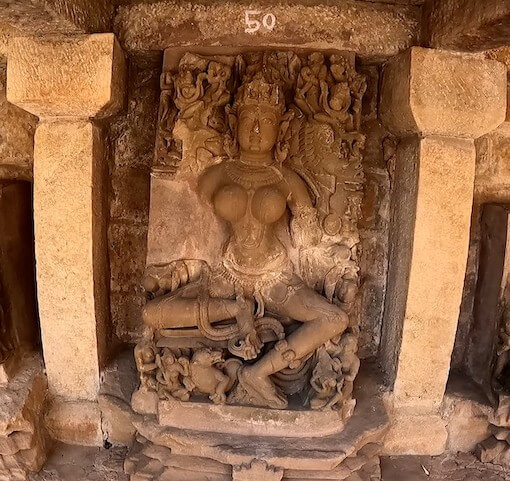
42. The beautiful sculpture with a serene countenance that can be seen in the niche numbered 50 is that of Sri Takari.

43. The headless sculpture of Sri Tapani can be seen in the next niche which is marked as 52.
44. The damaged sculpture of Sri Padmahamsa can be seen in the cell marked 54. Only the lower portion of the sculpture has survived, and the Yogini is seated in the Padmasana posture.
45. In the niche that has been marked as 55, is another damaged sculpture with only the lower portion surviving. This is the Yogini named Sri Hamsini. The figure of a swan can be seen beneath the pedestal.
46. Sri Isvari is the Yogini in the niche numbered as 62. This sculpture too is damaged and only the lower portion has survived.
47. Sri Thani is the Yogini seated in Lalitasana in the niche with number 63. It is interesting to note the mountain with six peaks that are depicted beneath the pedestal.
48. A headless Sri Indrajali is the next Yogini seated in Niche numbered 64 of the Chausath Yogini temple in Bhedaghat, Madhya Pradesh. The figure of an elephant can be seen beneath the pedestal.
49. Sri Gahani is the Yogini depicted in niche 65. This sculpture is damaged and headless. A Ram can be seen beneath the pedestal.
50. In niche that has been numbered 66, the sculpture is badly damaged and unrecognizable.
51. Sri Indrani is the Yogini in niche 67, however, the sculpture has been badly damaged, and only the legs of the deity and the lotus pedestal can be seen. An elephant can be seen beneath the pedestal.
52. Another damaged sculpture labelled as Sri Jha(?)ngini can be seen in the niche 68.
53. Sri Uttala is the Yogini in the niche numbered 69. The sculpture is damaged above the waist, a bull can be seen below the pedestal.
54. Another headless sculpture which is that of Sri Nalini occupies the niche 70.
55. Sri Lampata is the Yogini in niche number 71. The sculpture is headless, and a man can be seen lying beneath the pedestal.
56. Sri Deddri is the Yogini sculpture that you will see in the niche that has been numbered 73. This sculpture is also badly damaged. The figure of a horse can be made out beneath the pedestal.
57. Sri Rtsamada is the Yogini sculpture in the niche marked as 74. The sculpture is damaged and only the bottom portion has survived. Beneath the pedestal, the figure of an animal which seems to be a combination of Man, Boar, and Lion, can be seen.
58. Sri Gamdhari is depicted with wings and beneath her stands a horse. This complex sculpture can be seen in niche number 75 of the 64 Yogini temple in Jabalpur.
59. Sri Jahnavi or the Yogini associated with the River Ganga is the sculpture that can be seen in niche 76 of the Chausath Yogini temple of Bhedaghat. A Makara or crocodile can be seen beneath the pedestal on which the Goddess is seated in Lalitasana.

60. Sri Dakini is the Yogini that occupies niche 77. The sculpture is badly damaged and only the lower portion has survived.
61. Sri Vamdhani is the Yogini in niche 78. Only the lower torso and the pedestal of the sculpture have survived. Beneath the pedestal can be seen a group of men supporting it,
62. Sri Darppahari is the Yogini that can be seen in number 79. The sculpture is without a head, and a lion can be seen beneath the pedestal.
63. The sculpture of a headless dancing female can be seen in the niche marked 80.
64. Another dancing female figure is depicted in the niche that is marked as 81.
65. Sri Rangini is the Yogini who occupies the niche numbered 82. The upper portion is completely damaged. The figure of Garuda can be seen supporting the pedestal on which the Yogini is seated.
66. The headless sculpture of Sri Jaha can be seen in the niche numbered 83. A peacock can be seen beneath the pedestal.
67. Sri Thikkini is the Yogini sculpture that can be seen in the niche marked as 84. The head of the sculpture is damaged and the face is featureless. A parrot-like bird can be seen beneath the pedestal.
68. Sri Ghamtali is the female divinity that occupies the niche numbered 85. The sculpture has survived only below the waist. A bull can be seen below the pedestal.
69. Another damaged sculpture without the upper torso is that of Sri Dhadhdhari in niche numbered 86. An elephant can be seen beneath the pedestal.
70. The sculpture of a dancing female figure can be seen in niche 87.

71. Sri Vaishnavi, one of the Ashta Matrikas, is the Yogini sculpture in niche numbered 88. The figure of Garuda can be seen supporting the pedestal.
72. Sri Bhishani is the sculpture in niche number 89. The headless sculpture has a sleeping man beneath the pedestal.
73. Sri Satanusamvara is the Yogini in the niche that has been marked as 90.

74. Sri Kshetradharmini is the Yogini that occupies the niche 91. Beneath the pedestal can be seen an animal that is a combination of a lion, elephant, donkey, and Man.
75. A nameless female deity is the sculpture that can be seen in niche 92, a bull can be seen below the pedestal.

76. A beautiful sculpture of Sri Phanendri can be seen in niche 93. The sculpture is fairly well preserved. and has a grand crown. A male figure can be seen beneath the pedestal in a prostrate position.
77. Sri Virendri is the Yogini that occupies the niche numbered 94. The beautiful sculpture has the figures of a man as well as a horse below the pedestal.
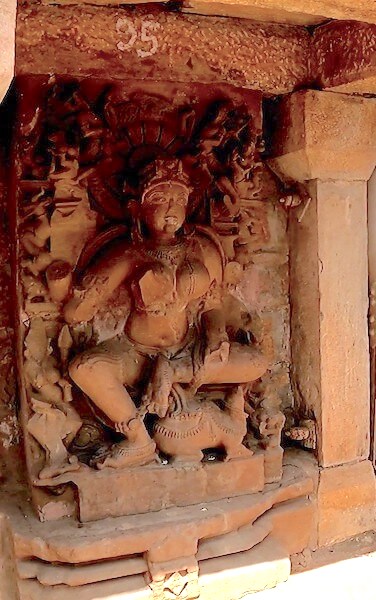
78. Sri Thakini is the Yogini that occupies the niche numbered 95. An animal that looks like a camel can be seen below the pedestal.
Architecture, Design, And Structure of Chausath Yogini Temple in Bhedaghat

The Chausath Yogini Temple in Bhedaghat near Jabalpur, State of Madhya Pradesh, India is believed to be one of the biggest and most impressive of the Chausath Yogini Temples. It stands atop a hill and is circular in shape. The old Tantric temple or Shakti temple has an inner diameter of about 116 feet and an outer diagram of 130 feet, according to a drawing by Alexander Cunningham who visited Jabalpur in 1874-75.
There are two entrances each with a width of about 20 feet, one is located in the West and one is located in the south. Today, one of these is closed, the entrance and exit are only through one of the doors. The Yogini sculptures along with a few other deities are housed in the circular and open walkway in individual niches.

In the centre of the circular temple is a platform with a canopy, and besides these can be seen a Shivling and some temple bells. In the north-western quadrant of the temple complex is a temple to Shiva known as Gauri-Shankar Temple, which was built around the 12th century. Inside the temple sanctum, one can see the main image is that of Shiva and Parvati, astride Nandi.
Most of the sculptures inside the temple are in bad condition, most of the images have heads and hands cut off, and only a few are recognizable. Some images have replaced the originals, in fact, one of the images of Kaumari, one of the Matrikas, is believed to be in the Mandla Archaeological Museum.
Images Of Chausath Yogini Temple Bhedaghat, Jabalpur | 64 Yogini Temple Jabalpur Photos

Here are some images of the 64 Yogini Temple Jabalpur (जबलपुर का चौसठ योगिनी मंदिर). Though Chausath Yogini meaning in Hindi refers to 64 Yoginis, historians are of the opinion that the Bhedaghat Chausath Yogini temple was built for 81 Yoginis in consonance with Sri Mattotara Tantra, which is an indication that the temple was built for royalty.
How to reach Chausath Yogini Temple, Bhedaghat near Jabalpur

The Chausath Yogini temple – 64 Yogini Temple Jabalpur is located in Bhedaghat near Jabalpur, Madhya Pradesh, India.
- The distance of Chausath Yogini Temple from Jabalpur city is about 33 kilometres
- Jabalpur is about 327 kilometres from Madhya Pradesh’s capital Bhopal
- Jabalpur is about 223 kilometres from Amarkantak from where the river Narmada originates
- Chausath Yogini Temple is about 34 kilometres from Jabalpur Airport
Reaching Jabalpur By Air
Jabalpur is serviced by Jabalpur Airport which is located about 25 kilometres from Jabalpur City. There are flights to and from cities like Delhi, Hyderabad, Mumbai, Pune, Bangalore, and other places.
Reaching Jabalpur By Train
The city of Jabalpur is serviced by the Jabalpur Railway Junction. Jabalpur is connected to places like Mumbai, Kashi, Patna, Secunderabad, Rameshwaram, Bangalore, etc., through the rail network.
Reaching Jabalpur By Road
Jabalpur is well connected to other cities and towns in Madhya Pradesh as well as other places in India through a good road network.
To travel to Jabalpur to visit the 64 Yogini Temple, you can book your flight tickets right here through Air India (Domestic) or Air India (International), or Priceline
and fly to Jabalpur. If you are thinking of a road trip to Jabalpur, Madhya Pradesh, do check out the rental car options.
Where To Stay When Visiting Chausath Yogini Temple Jabalpur

Jabalpur is a city that offers a range of accommodation options from budget to luxury. We stayed at the impressive Shawn Elizey Hotel in Jabalpur and found it quite good.
You can book your room at the Shawn Elizey or book online your stay in Jabalpur or anywhere in Madhya Pradesh, India right here – TripAdvisor or Hotels.com or HotelsCombined
.
| Click to book the best hotels in Jabalpur or the best hotels in Madhya Pradesh |
|---|
Other Yogini Temples In India

India has four major Chausath Yogini temples, and many minor ones, that are spread across its length and breadth. However, the temples are concentrated in the states of Madhya Pradesh, Uttar Pradesh, and Odisha.
The main and better-known Chausath Yogini Temples are the Chausath Yogini temple in Mitawali near Morena, the Chausath Yogini Mandir in Hirapur, Odisha, the 64 Yogini Temple Jabalpur near Bhedaghat, and the one in Khajuraho, Madhya Pradesh.
There are also Yogini temples in Ranipur-Jharial in Odisha, Dudahi in Uttar Pradesh, and Badoh in Madhya Pradesh. Many of these temples are in ruins and there is evidence of many temples that are lost to the world.
Evidence that points to the existence of Yogini temples in an earlier period have been found at Lokhari and Rikhiyan in Uttar Pradesh; Nareshwar, Shahdol, and Hinglajgarh in Madhya Pradesh; Kaveripakkam in Tamil Nadu. Some evidence of the existence of Yogini temples in Delhi and Varanasi has also been found.
Places Of Interest Near Jabalpur

Apart from the 64 Yogini Temple Bhedaghat Jabalpur, there are many interesting places to visit in and around Jabalpur. Here are some of the main attractions in Jabalpur and its vicinity.
- 64 Yogini Mandir Bhedaghat Jabalpur
- Dhuandhar Falls
- Marble Rocks
- Madan Mahal Fort
64 Yogini Temple Jabalpur – FAQ About Chausath Yogini Temple Bhedaghat

Who built the Chausath Yogini temple at Jabalpur?
The Chausath Yogini temple in Bhedaghat, Jabalpur is believed to have been built by the Kalachuri King Yuvaraja II.
Why is the Chausath Yogini temple famous?
The Chausath Yogini temple is a Tantric or Shakti temple dedicated to Yogini worship and has a unique architectural style and structure.
Who destroyed 64 Yogini temples? Who destroyed Chausath Yogini Temple?
The idols of the Chausath Yogini Temple in Jabalpur are believed to have been vandalized by marauding Mughal invaders.
What is the shape of 64 Yogini?
The Chausath Yogini temples are generally circular in shape.
How many 64 yogini Mandir are there in India?
There are many 64 Yogini temples in India, the main ones are the Chausath Yogini temple in Mitawali near Morena, the Chausath Yogini Mandir in Hirapur, Odisha, the 64 Yogini Temple Jabalpur near Bhedaghat, and the one in Khajuraho, Madhya Pradesh.
Which building design is based on the Chausath Yogini temple?
India’s Parliament building in Delhi is based on the design of the Chausath Yogini temple in Mitawali, near Morena, in the state of Madhya Pradesh.
We hope you found this post about the 64 Yogini Temple Jabalpur as interesting and fascinating as the place itself If you have not visited the unusual temple, do plan a visit to Jabalpur in Madhya Pradesh and visit this rare temple. Subscribe to our blog for more interesting and useful posts and do not forget to connect with us on our social media handles if you have not already done so.
We are a reader-supported site. This means, at no additional cost to you, we may earn a small commission if you book a flight or hotel, or make a purchase through one of our affiliate links. Thank you for your support!
Flights – Air India (Domestic) or Air India (International), or Priceline
Tours – Click to book top tours around the world. Book tours and activities here.
Experiences – Book your next unforgettable experience here, with flexible bookings and free cancellations. Reserve tours and activities now and pay later.
Hotels – Click to book the best hotels/resorts. Choose the best stay options with TripAdvisor or Hotels.com, or HotelsCombined
Travel Insurance – Click to book Travel Insurance that covers a range of travel insurance and safety services including medical emergencies, lost luggage, trip cancellation and more
Visas and Travel Documents Application – Click here for Online Travel Visa Check
Online Passport Photo – Get Your Passport Photo Online here
Do You Love Traveling?
Do you want to know how to travel the world? We have put together a very useful travel resources page with the best travel tips. Go check it out now. Thanks for visiting our site Voyager - imvoyager.com and taking the time to read this post! If you wish to collaborate/work with us then reach us at [email protected] We’d love it if you’d comment by sharing your thoughts on this post and share this post on social media and with your friends. Follow our journey on our social media channels: Facebook X Instagram Pinterest YouTube
Start dreaming about your next adventure with Tripadvisor. Book your next unforgettable experience here with flexible bookings and free cancellations.
Flight booking online at the best fare
60+ Million Users Trust TripAdvisor With Their Travel Plans. Shouldn't You?

Sandy & Vyjay are a husband and wife duo who are travel content creators. They are co-founders of this travel website and are one of the leading travel content creators in India.
Sandy & Vyjay quit their successful corporate careers to pursue their passion for travel and writing full-time. Their dedication has earned them the “Best Travel Writer” award and numerous accolades on both national and international stages. Focusing on India’s destinations, heritage, and culture, they are passionate advocates for nature and the environment. Through their content, they promote ecotourism and sustainable travel, inspiring others to explore and preserve the beauty of India.


